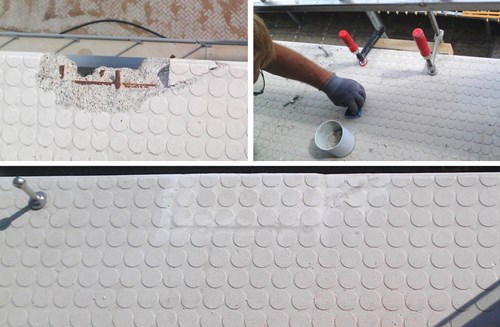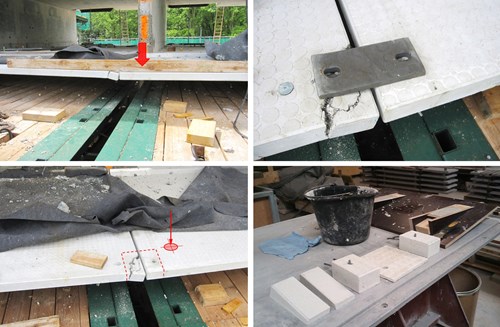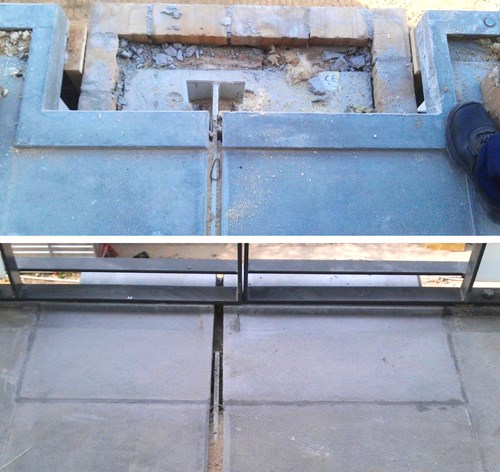11.06.2020 - Knowledge Center
Repairing UHPC elements

When considering using UHPC elements for a project, a recurring concern from the contractor is whether it is possible to make repairs to UHPC elements damaged or soiled during installation or the subsequent building process.
This is a legitimate concern because a) it is not realistic to assume that all elements will pass through the construction phase without even a single one being damaged, and b) repair mortars and techniques normally used for conventional concrete elements are inadequate to ensure sufficient quality of the repairs.
I have already briefly discussed cleaning in a previous post so in this post I’ll focus on a bit of advice on what to repair yourself and how, and when it is required to call a specialist – normally the supplier of the UHPC elements.
Repairs can be divided into two types: Smaller (superficial or aesthetic) repairs, and larger (structural) repairs. Generally speaking, smaller superficial repairs can be made by the contractor, whereas structural repairs need a specialist to ensure that the structural performance and durability of the element is retained (or restored).
When identifying which type you are facing, there are a few indicators to consider:
1. Scale: If the repair is less than 1-2 mm deep and covers less than a sheet of A4 paper in area, it is not compromising the cover layer significantly and does not require a specialist for structural reasons.
2. Location: Corners and edges are notoriously difficult to repair, especially on stairs with high wear load or on parapets that you touch with your hands. but in most other places it is safe to make smaller repairs yourself.
3. Cause: If the reason for the damage is fire, major impact, explosion or similar, the risk of hidden damage is likely and should be assessed by a specialist before repairs, but “normal” impact (dropping smaller equipment or props, elements brushing each other or other building parts during installation) normally is not a concern
4. Function: The function of the damaged part can sometimes be critical. An example could be a corner that is used to connect two elements using dowels – any damage to that area could compromise the connection and hence the overall safety. Another example is damage close to critical inserts or to the inserts themselves.
And of course, when in doubt, ask the supplier for advice – a few images by e-mail or via the mobile phone - is typically sufficient for a quick assessment of whether it is possible to repair yourself or not.
Making smaller repairs
Smaller repairs should be made using a repair material as close to the original mix as possible – the best is to get a small amount from the supplier incl. instructions on how to mix and apply it. For CRC i2®, Hi-Con supplies a special pre-mix identical to the material used to making finish works at our production sites.
This dry-mix is mixed with water to a consistency like chewing gum or clay, and applied after thorough cleaning of the damaged area. Just prior to the application, the surface is wetted using a sponge or a brush. After pressing the repair material hard into the repair cavity, it is left there for 15-30 minutes until its starts setting, and the surface can then be shaped / smoothened using a moist, firm sponge.
Prior experience with repair or finishing works is of course an advantage!
Larger repairs
Structural repair work should only be carried out by a specialist with experience in UHPC repairs, after preliminary assessment by the responsible project engineer.
For CRC i2® It is possible to cut, drill, glue, cast and even replace parts of elements, with proper assessment, calculation, planning and preparation, because of the ductility of the material. It is naturally difficult to perform larger repairs without any visual effects, but with skill and experience much can be accomplished as shown in the examples below. The two first cases are from the Poptahof project in Delft.

A repair large enough to need a replacement part because the concrete cover is compromised (upper left) after gluing in a repair part the joints are closed with repair material like a smaller repair (upper right) to yield the final result (lower image).

A structural repair after a large impact load (6 tons point load at the red arrow) needing structurally bearing replacement pieces. The reason was that the two elements were bolted together at the time of impact so the elements could not move freely (upper right). Production of various replacement pieces at Hi-Con (lower right).

Even an error in the design phase resulting in wrong geometry has been fixed through replacement pieces, in this case including drainage. The original drawings and measurements on-site were combined to produce drawings for moulds that exactly fit the replacement pieces with very narrow joints.
Summarizing
All repair work possible in conventional concrete is in principle also possible in UHPC – and then some – but requires specialized skill and knowledge.
As a contractor, the primary objective should always be to avoid soiling or damage to elements (UHPC or conventional), but should an accident happen, this should not be a concern limiting the use of UHPC.